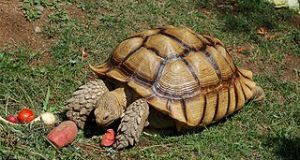 Asia’s Keeled Box Turtle, also known as the Jagged-shelled or Indian Thorn Turtle (Pyxidea mouhotii) is an attractive, interesting species that has somehow never become very popular with turtle keepers. Wild populations have plummeted in recent years and, as zoos pay little attention to this turtle, I’d like to ask that hobbyists consider working with it.
Asia’s Keeled Box Turtle, also known as the Jagged-shelled or Indian Thorn Turtle (Pyxidea mouhotii) is an attractive, interesting species that has somehow never become very popular with turtle keepers. Wild populations have plummeted in recent years and, as zoos pay little attention to this turtle, I’d like to ask that hobbyists consider working with it.
Description
I was taken in by the Keeled Box Turtle’s subtle beauty and unique shell construction early on. The extremely flat dorsal surface of the carapace is distinctive, as is the presence of the 3 well-defined keels or ridges that decorate it. The carapace, which reaches 7 inches in length, is brown, tan or rust in color and is serrated at the posterior. The limbs are gray to dark brown. A hinge develops in the plastron (lower shell) of the adults, allowing the head and front limbs to be sealed tightly into the shell.
Range and Habitat
The Keeled Box Turtle ranges widely throughout South and Southeast Asia, occurring from southern China (including Hainan Island) through Vietnam, Thailand and Myanmar to eastern India.
It is, however, rarely encountered as it prefers rainforests and heavily wooded areas. The Keeled Box Turtle may soak in shallow pools but rarely enters deep water.
Status in the Wild
As is true for many Asian turtles, the Keeled Box Turtle is declining throughout its range due to habitat loss and collection for the food trade. It is designated as “Endangered” by the IUCN and listed on Appendix II of CITES.
Further Reading
Please see the Turtles of the World website for more natural history information.
Keeled Box Turtle image referenced from wikipedia and originally posted by Torsten Blanck
 That Reptile Blog – Reptile, Amphibian and Exotic Pet Care and Information
That Reptile Blog – Reptile, Amphibian and Exotic Pet Care and Information


